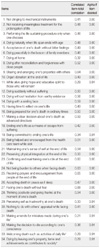Abstract
Methods
The process included construction of a conceptual framework, generation of initial items, verification of content validity, selection of secondary items, preliminary study, and extraction of final items. The participants were 428 adults who lived in one of 3 Korean metropolitan cities: Seoul, Daegu, and Busan. Item analysis, factor analysis, criterion related validity, and internal consistency were used to analyze the data. Data collection was done from March to June 2010.
Results
Thirty items were selected for the final scale, and categorized into 5 factors explaining 54.5% of the total variance. The factors were labeled as maintaining emotional comfort (10 items), arranging social relationship (9 items), avoiding suffering (3 items), maintaining autonomous decision making (4 items), and role preservation (4 items). The scores for the scale were significantly correlated with personal meanings of death scale. Cronbach's alpha coefficient for the 30 items was .92.
Figures and Tables
References
1. Abdel-Khalek AM. Why do we fear death? The construction and validation of the reasons for death fear scale. Death Studies. 2002. 26:669–680. doi:10.1080/07481180290088365.
2. Anderberg P, Lepp M, Berglund AL, Segesten K. Preserving dignity in caring for older adults: A concept analysis. Journal of Advanced Nursing. 2007. 59:635–643. doi:10.1111/j.1365-2648.2007.04375.x.
3. Chochinov HM. Dying, dignity, and new horizons in palliative end-of-life care. CA: A Cancer Journal for Clinicians. 2006. 56:84–103. doi:10.3322/canjclin.56.2.84.
4. Cicirelli VG. Personal meanings of death in relation to fear of death. Death Studies. 1998. 22:713–733. doi:10.1080/074811898201236.
5. Collett LJ, Lester D. The fear of death and dying. Journal of Psychology. 1969. 72:179–181.
6. Corless IB, Nicholas PK, Nokes KM. Issues in cross-cultural quality of life research. Journal of Nursing Scholarship. 2001. 33:15–20. doi:10.1111/j.1547-5069.2001.00015.x.
7. Curtis JR, Patrick DL, Engelberg RA, Norris K, Asp C, Byock I. A measure of the quality of dying and death: Initial validation using after-death interviews with family members. Journal of Pain and Symptom Management. 2002. 24:17–31. doi:10.1016/S0885-3924(02)00419-0.
8. Doorenbos AZ, Wilson SA, Coenen A, Borse NN. Dignifi-ed dying: A phenomenon and actions among nurses in India. International Nursing Review. 2006. 53:28–33. doi:10.1111/j.1466-7657.2006.00458.x.
9. Gauthier DM, Froman RD. Preference for care near the end of life: scale development and validation. Research in Nursing and Health. 2001. 24:298–306. doi:10.1002/nur.1031.
10. Greyson B. Cardena E, Lynn SJ, editors. Near-death experiences. Varieties of anomalous experience: Examining the scientific evidence. 2001. Washington, DC: American Psychological Association;315–352.
11. Harville M, Stokes SJ, Templer DI, Rienzi B. Relation of existential and religious variables to the death depression scale-revised. Omega. 2004. 48:165–184.
12. Holcomb LE, Neimeyer RA, Moore MK. Personal meanings of death: A content analysis of free response narratives. Death Studies. 1993. 17:299–318. doi:10.1080/07481189308252627.
13. Jacelon CS, Connelly TW, Brown R, Proulx K, Vo T. A concept analysis of dignity for older adults. Journal of Advanced Nursing. 2004. 48:76–83. doi:10.1111/j.1365-2648.2004.03170.x.
14. Jacobson N. Dignity and health: A review. Social Science and Medicine. 2007. 64:292–302. doi:10.1016/j.socscimed.2006.08.039.
15. Jo KH. The meaning of dignified dying perceived by nursing students. Journal of Korean Academic Society of Nursing Education. 2010. 16:72–82.
16. Jo KH, Lee HJ, Lee YJ. Types of students' death attitudes majoring in human service area: Q methodological approach. Journal of Korean Academy of Nursing. 2005. 35:829–841.
17. Kei HY. Constitutional law. 2005. Seoul: Pakyoungsa.
18. Kim CS. Constitutional law. 2008. 18th ed. Seoul: Pakyoungsa.
19. Kwon BG, Kim HC. Bioethics & law. 2009. Seoul: Ewha Womans University Press.
20. Kwon YS. Constitutional law. 2008. Paju: Bobmunsa.
21. Lee EO, Im RY, Park HA, Lee IS, Kim JI, Bae JI, Lee SM. Nursing Research and Statistical Analysis. 2009. Seoul: Soomoonsa.
22. Lee HK, Jo KH. A pathmodel for death anxiety to suicidal ideation of the elderly. Journal of the Korean Gerontological Society. 2006. 26:717–731.
23. Lee HS. Korean dictionary. 2008. Paju: Minjungsearim.
24. Lee YJ, Kim SM. Validating the Korean version of the preferences for care near the end-of-life (PCEOL-K) scale. Korean Journal of Medical Ethics. 2009. 12:29–42.
25. Leung D. Granting death with dignity: Patient, family and professional perspectives. International Journal of Palliative Nursing. 2007. 13:170–174.
26. Lynn MR. Determination and quantification of content validity. Nursing Research. 1986. 35:382–385.
27. Proulx K, Jacelon C. Dying with dignity: The good patient versus the good death. American Journal of Hospice and Palliative Care. 2004. 21:116–120. doi:10.1177/104990910402100209.
28. Pullman D. Death, dignity and moral nonsense. Journal of Palliative Care. 2004. 20:171–178.
29. Ryu CS. SPSS 14.0 for Windows. 2006. 5th ed. Seoul: Elite.
30. Skevington SM, Bradshaw J, Saxena S. Selecting national items for the WHOQOL: Conceptual and psychometric considerations. Social Science and Medicine. 1999. 48:473–487. doi:10.1016/S0277-9536(98)00355-4.




 PDF
PDF ePub
ePub Citation
Citation Print
Print







 XML Download
XML Download